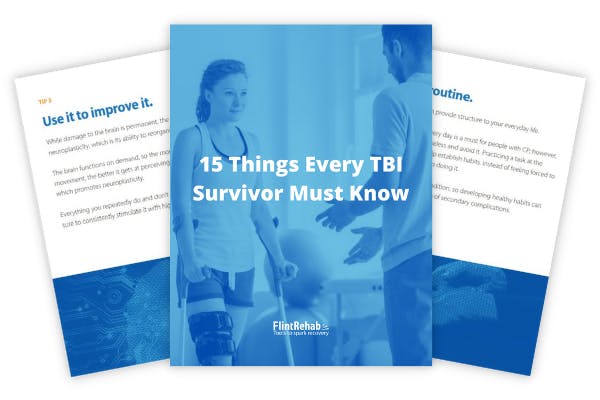Gabapentin and Brain Damage: Side Effects and Benefits
Gabapentin has been successfully used to treat some of the effects of brain damage. However, prolonged use can cause serious side effects.
Today you will learn more about the use of gabapentin for brain injury and what symptoms it can help relieve.
What Is Gabapentin Used For?
Gabapentin is an anticonvulsant medication primarily used to treat partial seizures and neuropathy.
It is also one of the few drugs that can cross the blood-brain barrier and enter the central nervous system. It works by changing the way nerves send messages to the brain.
For people without brain damage, pain is detected in the following way:
- Nociceptors (pain receptors) in the skin send pain signals via the peripheral nerves to reach the dorsal horn in the spinal cord.
- The dorsal horn passes these signals on to the thalamus in the brain.
- The thalamus sorts out the pain signals and relays them to different parts of the brain, such as the somatosensory cortex.
These parts of the brain translate sensation into pain.
After a brain injury, however, this process can become distorted, depending on which part of the brain the injury damaged. As a result, your brain can get confused and think your body is being harmed when in reality it is not. This causes neuropathic pain.
Gabapentin works by suppressing the activity of pain nerves, which can help relieve pain. By calming down the nerves it can also reduce seizure frequency.
Pain and seizure management is the most common use for gabapentin after brain damage. But it has also been used successfully to treat autonomic dysfunction.
What Is Autonomic Dysfunction?

Autonomic dysfunction refers to problems with the autonomic nervous system (ANS).
The autonomic nervous system is a network involving the amygdala, hypothalamus, and brain stem. It controls all involuntary bodily functions, such as:
- Heart rate
- Blood pressure
- Digestion
- Body temperature
The ANS has two distinct branches, each with its own purpose:
- Sympathetic nervous system (SNS). This branch controls the body’s “fight or flight” response. When the sympathetic nervous system activates, your body releases adrenaline, which triggers a cascade of responses such as increased heart rate and rapid breathing.
- Parasympathetic nervous system (PNS). This response counters the sympathetic response by dampening adrenaline and lowering heart rate and blood pressure.
However, if an injury damages the parts of the brain that control this process, the parasympathetic nervous system cannot respond. As a result, the SNS will continue to put the body into a state of distress.
If the brain damage was severe, the brain will flood the body with adrenaline and other hormones. And if this goes on too long, storming after brain injury will occur.
Symptoms of Autonomic Dysfunction After Brain Damage
Autonomic dysfunction can cause various secondary effects. Some of these include:
- Decreased immune system
- Dizziness and fainting upon standing up
- High or low blood pressure
- Light sensitivity
- Excessive sweating
- Digestive problems
- Cold or heat sensitivity
Thus, depending on how much of your ANS was damaged, you can experience one or all of these symptoms. Their effects can also range from mild to severe.
In addition, autonomic dysfunction, if left untreated for too long, can cause cardiac problems, including arrhythmias, arterial blockage, and heart attack.
Therefore, it is crucial to diagnose and treat autonomic dysfunction as soon as possible. Fortunately, gabapentin can relieve many of these symptoms
Gabapentin for Autonomic Dysfunction After Brain Damage

Recently, researchers have shown that gabapentin can effectively manage the effects of autonomic dysfunction, especially after severe brain damage.
For example, in one study that examined six severe brain injury patients with dysautonomia, doctors found that gabapentin significantly decreased dysautonomia symptoms.
In fact, it had a stronger effect than medications traditionally used to treat autonomic dysfunction. And because gabapentin also treats pain and seizures, it can allow an “overall reduction in medication without recurrence in symptoms.”
All of this makes gabapentin a promising drug for brain damage patients.
Side Effects of Gabapentin on Brain Injury
While gabapentin can be beneficial for brain injury patients, it does have serious potential side effects.
Some of the most common side effects of gabapentin include:
- Abnormal eye movements
- Coordination and balance problems
- Nausea
- Drowsiness
- Trouble speaking
- Swelling in hands and feet
In addition, many brain injury patients experience heightened anxiety and restlessness when taking gabapentin. But this is more common in patients with cognitive impairments.
Treating Brain Damage with Gabapentin
Gabapentin can be an effective treatment for many brain damage symptoms, especially neuropathy, seizures, and autonomic dysfunction.
However, it is not without side effects or risks. Therefore, consult with your doctor before trying it, and alert your doctor immediately when side effects appear.
We hope this article has given you a clearer picture of the benefits and risks of using gabapentin after brain injury.
Keep it going: Do you know these 15 essential TBI recovery tips?

If you like our content, you’ll love our ebook and newsletters! Get instant access to our TBI recovery tips ebook with 20 pages of helpful advice by signing up below.
You’ll also receive our emails that share survivor stories and more useful TBI recovery tips, which you can opt out of at any time. (We know you’ll love them, too.)
We will never sell your email address, and we never spam. That we promise.
